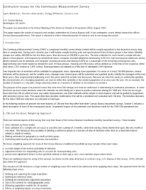Estimation Issues for the Continuous Measurement Survey
Estimation Issues for the Continuous Measurement Survey
Introduction
The Continuous Measurement Survey (CMS) is a proposed monthly survey whose content will be roughly equivalent to the decennial census long form or sample data. During each calendar year it will include sample housing units and special places from all block groups in the nation. Monthly sample size will be 400,000 for the first three years, then decrease to 250,000 in year four. The data collection for each month's sample will take place in three phases: self-response by mailout/mail return; computer-assisted telephone interviewing (CATI) for mail nonresponse addresses whose phone numbers can be obtained; and computer-assisted personal interviewing (CAPI) for a subsample of the remaining nonresponse units. Approximately one month would be allowed for each of these phases. Housing unit (HU) status will be defined as of the time of first response: either mail return, CATI contact or CAPI contact. Nonrespondents are defined as of the time of attempted CAPI interview.
Two separate sets of estimates will be available for geographic areas, depending upon population. For areas of at least 250,000 persons, annual estimates will be produced, and for smaller areas averages over several years will be estimated and updated yearly. Initially the averages will be over three years, then progressively lengthening out to five years when the sample size decreases. Because we view this survey as continually updating the characteristics of a changing population, we want to reflect the variability in the resident population of an area over the year. (As an example, the number of students in a city with a large university varies as a function of whether or not school is in session.)
The purpose of this paper is to present issues that arise from CM's design and must be addressed in determining its estimation procedures. In some instances we have made decisions about the methods we will initially put in place to produce estimates during the 1996 test. Since we do not yet have data from CM on which to base any subtle improvements, our initial methods will be simple in most respects and will be guided by experience with decennial census data. The paper describes possible modifications that will be considered and evaluated with CM data. The tentative decisions for the initial 1996 test estimates are indicated on bold type.
In the following section we present the main features of CM and how they differ from other Census Bureau household surveys. Section 3 includes a short description of each of the consequent issues, its potential impact on the estimates and decisions made for the 1996 CM operational test.
Others in Series
Working Paper
Working Paper
Working Paper




